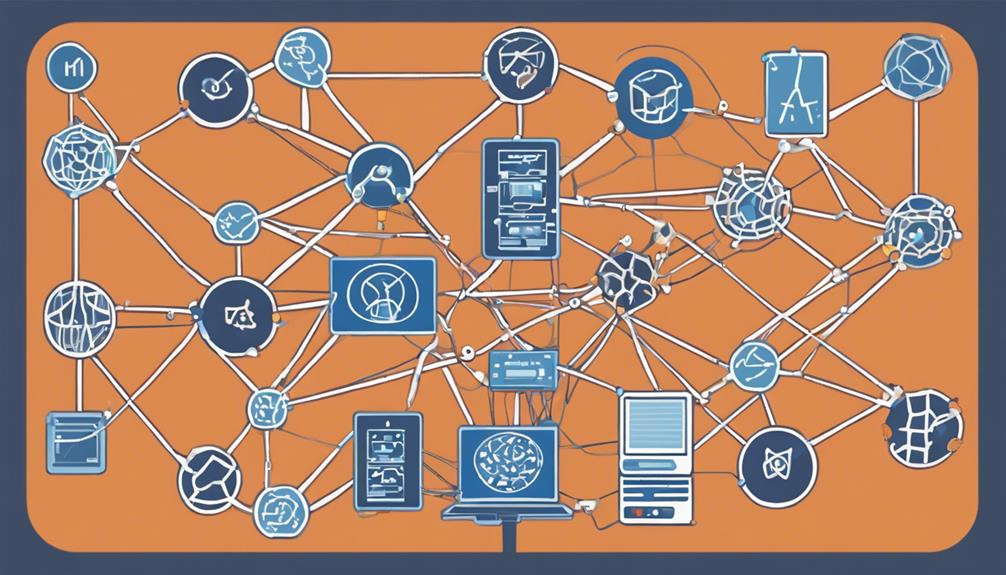As you navigate the vast landscape of web data mining, it’s intriguing to observe how the evolution of techniques has reshaped the digital terrain. From its rudimentary beginnings to the sophisticated algorithms of today, the journey has been marked by transformative strides. Curious to explore how these advancements have revolutionized the way organizations harness insights from the digital realm to drive strategic decisions and gain a competitive edge?
Historical Development
Throughout the evolution of web data mining, the historical development of this field has been marked by significant milestones that have shaped its current landscape. Early techniques in web data mining primarily revolved around basic data extraction and keyword analysis to gather insights from the vast amount of information available online. Foundational concepts such as pattern recognition, clustering, and classification laid the groundwork for more advanced data mining processes.
In the initial stages, web data mining involved manual extraction and analysis of data from websites, limiting the scale and efficiency of the process. However, as technology progressed, automated tools and algorithms were developed to streamline data extraction and analysis, leading to more sophisticated mining techniques. These advancements enabled the extraction of valuable insights from unstructured data sources, such as social media platforms and online forums.
Technological Advancements
As you explore the evolution of web data mining, it is crucial to examine the advancements in data collection methods and machine learning techniques. These two key points have played a significant role in shaping the landscape of web data mining over the years. Understanding the evolution of these technological aspects provides valuable insights into the current capabilities and future potential of web data mining.
Data Collection Methods
Advancements in technology have revolutionized the field of data collection methods, enabling researchers to gather information more efficiently and comprehensively. Data scraping, a technique where software extracts data from websites, has become increasingly sophisticated. This method allows for the automated retrieval of structured data from web pages, saving time and resources. Text mining, another key method, involves analyzing unstructured text data to uncover patterns and extract valuable insights. With the help of natural language processing algorithms, researchers can sift through vast amounts of text data to identify trends and sentiment.
These data collection methods have evolved significantly over time, thanks to technological innovations. Machine learning algorithms now assist in improving the accuracy and efficiency of data scraping and text mining processes. Additionally, cloud computing capabilities have enabled researchers to store and process large amounts of data more effectively. As technology continues to advance, data collection methods are expected to become even more sophisticated and powerful, driving further advancements in the field of web data mining.
Machine Learning Techniques
The utilization of machine learning techniques represents a significant technological advancement in the realm of web data mining. Feature selection plays a crucial role in enhancing the performance of machine learning models by identifying the most relevant data attributes for analysis. This process aids in reducing noise and improving the accuracy of predictions, ultimately leading to more effective decision-making based on the web data collected.
Model evaluation is another key aspect of machine learning techniques in web data mining. It involves assessing the performance of different models to determine their effectiveness in handling the data at hand. By comparing various models based on metrics like accuracy, precision, recall, and F1 score, data miners can select the most suitable model for their specific analytical needs.
Incorporating advanced machine learning techniques such as feature selection and model evaluation has revolutionized the way web data mining is conducted, enabling more accurate insights and predictions to be derived from the vast amounts of data available online.
Scope of Application
Web data mining has a broad scope of application across various industries, allowing organizations to extract valuable insights from the vast amount of data available on the internet. By leveraging web data mining techniques, businesses can gain profound industry insights and stay ahead of emerging market trends. In the realm of e-commerce, companies analyze customer behavior on websites to personalize marketing strategies and enhance the overall shopping experience. In finance, web data mining helps in detecting fraudulent activities, predicting market fluctuations, and optimizing investment strategies. Health organizations utilize web data mining to track disease outbreaks, analyze patient data for personalized treatment plans, and improve healthcare delivery. Moreover, in the field of social media, companies employ data mining to understand consumer sentiment, tailor advertising campaigns, and identify influencers for targeted promotions. The scope of application for web data mining continues to expand, offering organizations a competitive edge by uncovering hidden patterns and valuable insights within the vast online landscape.
Evolution of Techniques
Over time, data mining techniques have undergone significant transformations to adapt to the evolving landscape of web data. Algorithm optimization has played a crucial role in enhancing the efficiency and accuracy of data mining processes. By fine-tuning algorithms to handle large datasets and complex patterns, researchers have been able to extract valuable insights from web data more effectively.
Moreover, feature engineering has emerged as a pivotal technique in the evolution of data mining. This process involves selecting, modifying, or creating new features from existing data to improve the performance of machine learning models. With the exponential growth of web data, feature engineering has become essential for enhancing predictive modeling and uncovering hidden patterns within the vast amount of information available online.
Future Trends in Data Mining
As we look ahead to the future of data mining, one can anticipate a continued emphasis on enhancing algorithmic capabilities and leveraging innovative technologies to extract deeper insights from vast and complex datasets. Algorithm development will play a pivotal role in advancing the field, enabling more sophisticated analysis and pattern recognition. This evolution will not only benefit industry applications but also raise ethical considerations and privacy concerns.
In the coming years, data mining practitioners will need to address the ethical implications of their work, ensuring that data is used responsibly and in compliance with regulations. Privacy concerns will also remain at the forefront, necessitating the development of robust data protection measures to safeguard sensitive information.
Moreover, the integration of data mining with machine learning will further revolutionize the field, enabling more efficient and accurate predictive modeling. By staying abreast of these future trends, data miners can navigate the evolving landscape of technology and analytics, shaping a more informed and conscientious approach to data-driven decision-making.
Machine Learning Integration
As you explore the realm of web data mining evolution, it is crucial to consider the integration of machine learning. Machine learning plays a pivotal role in enhancing data extraction processes, enabling more efficient and accurate retrieval of valuable information from vast datasets. Moreover, machine learning techniques are instrumental in pattern recognition and predictive analytics, empowering organizations to derive actionable insights and make informed decisions based on data-driven predictions.
ML in Data Extraction
Data extraction is a crucial aspect of web data mining, enabling organizations to gather valuable insights from vast amounts of unstructured data. Machine learning (ML) plays a significant role in enhancing data extraction processes. ML algorithms can aid in feature selection, helping to identify the most relevant data points for extraction. This, in turn, improves the efficiency and effectiveness of the extraction process by focusing on key information.
Text classification is another essential application of ML in data extraction. By employing text classification algorithms, organizations can automatically categorize and organize textual data from websites, making it easier to extract relevant information based on predefined categories. This streamlines the extraction process and enables organizations to extract specific types of data more accurately and efficiently.
Incorporating ML into data extraction not only enhances the speed and accuracy of the process but also allows organizations to extract valuable insights from web data that would otherwise be challenging to obtain manually. By leveraging ML for data extraction, organizations can unlock the full potential of web data mining for informed decision-making and strategic planning.
ML for Pattern Recognition
Enhancing the capabilities of web data mining, Machine Learning (ML) for pattern recognition serves as a pivotal component in the integration of advanced technologies for efficient data extraction and analysis. Pattern recognition algorithms play a crucial role in ML for identifying meaningful patterns within data, enabling tasks like image classification and natural language processing to be automated with precision.
In the realm of web data mining, ML-driven pattern recognition algorithms have revolutionized the way data is processed and understood. By leveraging deep learning applications, computers can now recognize intricate patterns in images, text, and other forms of data, leading to more accurate insights and decision-making processes.
The integration of ML for pattern recognition has significantly improved the efficiency and accuracy of web data mining tasks, allowing for faster and more reliable extraction of valuable information from vast datasets. As technology continues to advance, the role of ML in pattern recognition will only become more integral in unlocking the full potential of web data mining.
ML for Predictive Analytics
Integrating Machine Learning (ML) for predictive analytics marks a significant advancement in the realm of data analysis and decision-making. By harnessing ML algorithms, organizations can now leverage historical data to forecast future trends and outcomes with remarkable accuracy. One key aspect of ML for predictive analytics is data visualization, which plays a crucial role in understanding complex patterns and relationships within the data. Through visual representations such as charts, graphs, and dashboards, insights can be gained more effectively, enabling informed decision-making processes.
Moreover, model interpretation is another critical component when utilizing ML for predictive analytics. Understanding how the ML models arrive at their predictions is essential for building trust in the results and refining the models for improved accuracy. Interpretability allows stakeholders to grasp the reasoning behind the predictions and validate the credibility of the outcomes. Overall, the integration of ML for predictive analytics empowers organizations to make data-driven decisions that drive success and innovation.
Impact on Business Strategies
Business strategies have undergone a significant transformation due to the evolution of web data mining. Businesses now have the ability to delve deep into competitive analysis and market segmentation using data mined from the web. By leveraging web data mining techniques, companies can gain valuable insights into their competitors’ strategies, strengths, and weaknesses. This allows for a more informed decision-making process, enabling businesses to stay ahead in the market.
Market segmentation has also been revolutionized through web data mining. Companies can now tailor their products and services to specific customer segments based on the data collected from various online sources. This personalized approach enhances customer satisfaction and loyalty, ultimately leading to increased profits and market share.
Frequently Asked Questions
What Ethical Considerations Are Important in Web Data Mining?
When considering ethical implications in web data mining, it’s crucial to prioritize data protection. Safeguarding personal information and being transparent about data collection practices are essential. Upholding ethical standards builds trust with users and enhances accountability.
How Does Web Data Mining Handle User Privacy Concerns?
When it comes to handling user privacy concerns, web data mining prioritizes privacy protection through user consent. Anonymization techniques and robust data security measures are implemented to safeguard personal information and ensure ethical data practices are maintained.
Are There Regulations Governing Web Data Mining Practices?
Regulatory compliance and industry standards govern web data mining practices. It ensures ethical and legal use of data. Adhering to these guidelines promotes transparency, accountability, and trust. Stay informed about evolving regulations to navigate the digital landscape responsibly.
What Are the Common Challenges Faced in Web Data Mining Projects?
When tackling web data mining projects, you’ll encounter challenges like data cleaning to ensure accuracy and algorithm selection for optimal results. These tasks demand careful consideration and expertise to navigate effectively.
How Does Web Data Mining Address Data Quality and Reliability Issues?
When you engage in web data mining, you enhance data accuracy by utilizing tools for data validation. By verifying and cleansing data, you ensure its quality and reliability, improving the overall effectiveness of your mining efforts.



